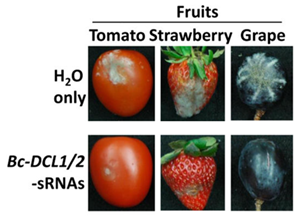Plants Resistant to Fungal Disease
Background
Botrytis cineria and Verticillium dahlia are fungal diseases that infect more than 200 plant species. Botrytis cineria alone infects almost all vegetable and fruit crops and annually causes $10 to $100 billion in losses worldwide. Methods of controlling both fungal diseases include fumigating with methyl bromide, and applying fungicides and biological controls. However plants that are genetically resistant to both diseases and do not require additional pest control methods are desirable.
Brief Description
University of California, Riverside researcher Prof. Hailing Jin and her colleagues have developed plants that are resistant to Botrytis cineria and Verticillium dahlia. These plants are genetically engineered to silence fungal pathogens that transfer “virulent” small RNA effectors to the plant that cause disease. This has led to the development of plants that are resistant to Botrytis cineria and Verticillium dahlia.

Fig. 1 shows fruits (bottom) with dramatic reductions in gray mold disease. Gray mold disease is caused by Botrytis cineria. The bottom fruits were sprayed with small RNA (sRNA) against Botrytis cineria pathogens dicer-like 1 & 2 (BcDCL). The top fruits were sprayed with water and this conferred no protection against gray mold disease. Immunity to pathogens may be genetically engineered into plants to express BcDCL-1 and BcDCL-2.
Suggested uses
This technology may be used to develop crops that are resistant to Botrytis cineria and Verticillium dahlia and that do not require fungicides or biological controls.
Patent Status
| Country | Type | Number | Dated | Case |
| United States Of America | Issued Patent | 11,085,051 | 08/10/2021 | 2015-053 |
| United States Of America | Issued Patent | 10,724,049 | 07/28/2020 | 2015-053 |
Contact
- Rekha Chawla
- rekha.chawla@ucr.edu
- tel: View Phone Number.
Other Information
Keywords
fungal, small RNA, DCL, sRNA, pathogenicity, immunity, host, Botrytis cineria, Verticillium dahlia, pathogens, gray mold
